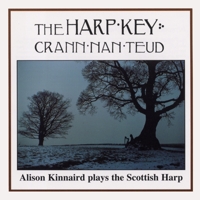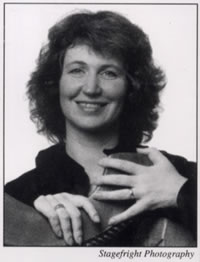The Harp Key by Alison Kinnaird
'The Scottish harp can never have had a
better showcase than this' MELODY MAKER Buy this album now CD: £11.50 + p&p |
| 1 | Rory Dalls Port | Trad | 4:17 |
| 2 | Princess Augusta | Trad | 1:48 |
| 3 | Caoineadh Rioghail (The Royal Lament) | Trad | 2:59 |
| 4 | Glenlivet Castle Drummond | Trad | 2:22 |
| 5 | Balquhidder | Trad | 2:08 |
| 6 | Fliuch An Oidhche Heman Dubh | Trad | 1:59 |
| 7 | Port Atholl | Trad | 3:47 |
| 8 | Killiecrankie | Trad | 3:06 |
| 9 | Cumha Crann Nan Teud (The Lament for the Harp Key) | Trad | 8:13 |
| 10 | The Kid On The Mountain | Trad | 2:11 |
| 11 | Fuath Nam Fidhleirean (Contempt for Fiddlers) | Trad | 1:58 |
| 12 | Chapel Keithack | Wm. Marshall | 2:29 |
| 13 | Grantown-on-Spey | Trad | 2:39 |
| 14 | Port Patrick | Trad | 3:11 |
| 15 | The Rymer | Kinnaird | 2:45 |
| 16 | The Duchess of Buccleuchs Favourite The Earl of Hadinton Miss Charlotte Brodies Jig |
Trad | 4:16 |
TOTAL DISC TIME |
50:34 |
||
Sleeve Notes Since recording this album 17 years ago, a great deal of new information has come to light about the harp, its origin and music. The evidence shows that the triangular pillar harp appears first on Pictish Stones on the East Coast of Scotland from the 8th century onward. These are relatively large, lightly-built instruments, probably strung with horse-hair, and subsequently, under Anglian influence, with gut-strings. The harp's movement westwards can be traced on the stones, until it came in contact with the Gaels. No evidence of triangular harps is found in Ireland at this point, though they played quadrangular harps and lyres. The Gaels retained the Irish preference for wire-strings, and adapted the triangular harp to carry the greater tension required, resulting in a compact, sturdy harp, with a one-piece sound-box - the 'clarsach '. It is clear that historically the name
'clarsach' referred to the wire-string harp of the Gael, played
in the West Coast and Highland areas, while the gut-strung harp
was predominantly played in the East Coast and Lowland areas. Both
small harps were played for many hundreds of years - the gut-strung
harp was overtaken by the development of the European pedal-harp,
and the wire-strung clarsach disappeared with the demise of bardic
culture and its patrons after the Jacobite risings. Alison Kinnaird, August 1995 THE CLARSACH - THE SCOTTISH HARP The harp is first found in Scotland in Pictish areas around the eighth century. By the twelfth century it had become so common that Giraldus Cambrensis, a Welsh Scholar, wrote of Scottish harping, "In the Opinion of many, however, Scotland has not only attained to the excellence of Ireland, but has even, in musical science and ability, far surpassed it, insomuch that it is to that country that they now resort as to the genuine source of the art". Harps were played throughout Scotland. In the lowlands, at the Royal Court, James the First and it is said Mary, Queen of Scots, performed upon the harp - and of course there were many professional harpers. These travelling harpers are found as characters· in many of the ballads such as "Binnorie", "Glenkindie" and "The Harper of Llochmaben". In the Highlands the wire-strung clarsach was also an instrument of the aristocracy, and a harper was frequently employed as a member of the Chief's establishment. He performed at public occasions of celebration or mourning, and was apparently expected to lull the household to sleep (as the piper roused them in the morning). The last professional harper in Scotland appears in the records of Macleod of Dunvegan in 1755. With the changing social pattem, the breakdown of the clan system, and the disappearance, or anglicization, of the Highland chiefs, the harping tradition was broken. One hundred and fifty years earlier a similar process of the anglicization of the Royal Court had had similar effects in the lowlands, whereas in Ireland, the last harper to play in the old style, Denis Hempson, played at the Belfast Harp Festival of 1792, about forty years after the Dunvegan harper. The Irish and Scottish harps have remained fairly similar though the Scottish harp has retained the "Highland Hump" - the point at the top of the harmonic curve which gives extra length and tone to the treble strings. In the seventeenth century brass blades were introduced at the top of each string on gut-strung harps, which when turned, raise each note a semitone. There are two surviving examples of old Scottish clarsachs in the National Museum of Antiquities; the Lamont Harp, which is traditionally said to have come from fifteenth century Argyll, and the Queen Mary Harp, presented by Mary, Queen of Scots to the family of Lude, in Perthshire. With the revival of interest in Celtic traditions at the end of the Iast century, harps were again made and played in Scotland. The modern harp has about the same number of strings as that of the seventeenth century, i.e. between 29-31, and is almost always strung with gut. There is much enthusiasm for the instrument and one can say that it is now as widely played as at any time in its history. THE MUSIC OF THE CLARSACH Most of the known Scottish harp tunes are attributed to Rory Dall. Blind Roderick Morison, or Rory Dall, lived c 1660 - 1713, and was the harper to the Macleods of Dunvegan. However there was also an Irish harper named Rory Dall O'Cathain who travelled in Scotland during the first half of the seventeenth century, and it is impossible to ascribe most of the tunes positively to one or the other. It is possible that those pieces collected in Perthshire, such as Port Atholl or Port Patrick, were by the Irish Rory Dall, but it does seem likely that the tunes were composed in Scotland, partly because of their titles, and also because most of them are in a "Scottish style". The characteristic form of Scottish harp music seems to have been a theme with variations - a form of music which was also developed by the Highland pipers as pibroch. It is noticeable that of the many O'Carolan tunes, the only two that have variations are on Scottish themes, "When she cam ben she Bobbit" and "Cock up your Beaver". This is rather surprising in view of the amount of travelling that the harpers did between Scotland and Ireland, and the extensive exchange of tunes and ideas. Many tunes turn up in both countries under different titles, such as Killiecrankie and Planxty Davis, and some terms used in pibroch were taken down by Bunting from the harpers in Belfast in 1792. Unfortunately none of the harpers, in Scotland or in Ireland, ever wrote their music down, so those pieces which exist were collected and written down by fiddlers, pipers and flute players. There is thus no authentic guide as to what harmonies were used, since even Bunting, transcribing direct from the last of the harpers in the old style, tended to "improve" upon their rendering of the tunes. However from the literary evidence, and from the nature of the instrument it does seem certain that the harp was not used purely as a melody instrument. The sparing use of harmony in the rest of the musical tradition increases the problem of reconstructing the pieces into a playable form. This I have done partly from the written evidence and partly from observation of the traditional music as played on other instruments. It therefore would not be claimed that this record is an exact example of how the clarsach was played in the eighteenth century. But hopefully it will demonstrate that the Scottish harp, as a solo instrument, still has a strength and a character of its own. Alison Kinnaird 1978 1 RORY DALL's PORT 2 PRINCESS AUGUSTA 3 CAOINEADH RIOGHAIL
- THE ROYAL LAMENT 4 GLENLlVET/CASTLE
DRUMMOND 5 BALQUHIDDER 6 FLIUCH AN OIDHCHE/HEMAN
DUBH 7 PORT ATHOLL 8 KILLIECRANKIE 9 CUMHA CRANN NAN
TEUD - THE LAMENT FOR THE HARP KEY 10 THE KID ON THE
MOUNTAIN 11 FUATH NAM FIDHLEIREAN
- CONTEMPT FOR FIDDLERS 12 CHAPEL KEITHACK 13 BAILE NAN GRANNDACH
- GRANTOWN-ON-SPEY 14 PORT PATRICK 15 THE RYMER 16 THE DUCHESS OF
BUCCLEUCH'S FAVOURITE/THE EARL OF HADINTON/MISS CHARLOTTE BRODIES
JIG |
Credits Produced by Robin Morton |
| Instruments: | Harp |
| Genre: | Scottish Traditional |
| Format: | CD |
| Our Ref: | A0146 |
| MCPS: | COMD 1001 |
| Label: | Temple Records |
| Year: | 1979 |
| Origin: | Manufactured in Austria |
|
|
| Contact Details | Please use form on Alison's web site click here |
| Artist Web Site | www.alisonkinnaird.com |

 Alison
Kinnaird is recognised as one of the foremost exponents
of traditional Scottish harp music. Alison's first instrument
was cello and she was a founder member of the Edinburgh Youth
Orchestra. She has a degree in Celtic Studies and Archaeology
and studied the harp under Jean Campbell in Edinburgh from the
age of 14. She has won the Clarsach Trophy at the National Mod
and the Harp Competition in Pan Celtic Festival in Killarney.
Alison
Kinnaird is recognised as one of the foremost exponents
of traditional Scottish harp music. Alison's first instrument
was cello and she was a founder member of the Edinburgh Youth
Orchestra. She has a degree in Celtic Studies and Archaeology
and studied the harp under Jean Campbell in Edinburgh from the
age of 14. She has won the Clarsach Trophy at the National Mod
and the Harp Competition in Pan Celtic Festival in Killarney.









